Gaia Sky
Tutorial
Toni Sagristà Sellés
tsagrista@ari.uni-heidelberg.de
MWGaiaDN Induction School, PLNT Leiden
2 February 2024
Find this presentation at:
gaia.ari.uni-heidelberg.de/gaiasky/presentation/202402/mwgaiadn/
Written notes for this session:
gaia.ari.uni-heidelberg.de/gaiasky/docs/master/workshops/mwgaiadn-plntleiden-2024.html
Introduction
What is Gaia Sky?
Gaia Sky
- 3D Universe software platform similar to Celestia or OpenSpace
- Multiplatform → Linux, Windows, macOS
- Open source and libre
- Focus on Gaia and its data
- Outreach material production
Gaia Sky Features
- 4 camera modes
- Seamless navigation
- 6D exploration → $x$ + $\mu$
- Full VR support → OpenXR API
- Interactivity with Gaia data → LOD
- Panorama, planetarium, orthosphere
- Stereoscopic mode (3D)
- Sparse virtual textures
- Elevation representation
- Ray-marched objects
- External datasets → VOTable, FITS, csv
- Filtering and color mapping
- SAMP integration
- Camera paths and keyframing
- Scripting API
- Many more...
Operation
Basic Controls and Modes
Welcome Screen
- Access to dataset manager
- Download datasets
- Enable/disable datasets
- Update datasets
- Delete datasets
- Preferences, help, etc.
Basic Movement
Drag mouse to rotate, scroll to move, hold to roll
Also, use the cursors to move:
Object Selection
Select objects by:
- Double-clicking on them
- Search by name (press )
User Interface
Control and Information Panes
UI Overview


Control Panes
- Time
- Camera
- Visibility
- Visual Settings
- Datasets
- Location Log
- Bookmarks
Time Pane
- Start/pause time
- Change time warp and
- Set and reset time +
Camera Pane
Camera modes:
- Free
- Focus
- Game
- Spacecraft
Visibility Pane
- Turn on/off object types
- Control individual object visibility
Datasets Pane
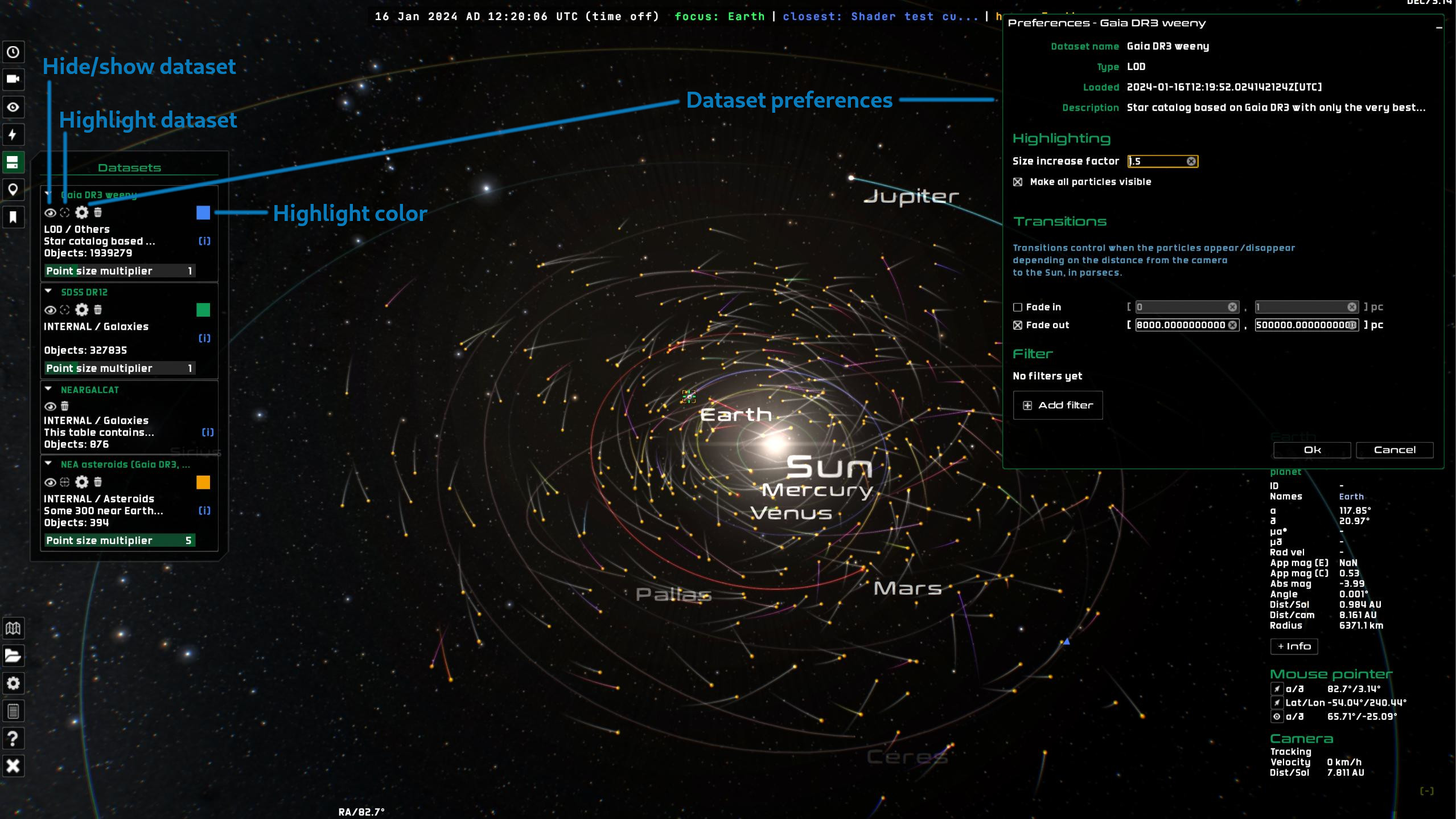
Datasets Pane
- Show/hide datasets
- Highlight datasets
- Delete datasets
- Per-dataset point size (when applicable)
- Dataset preferences
External Information

External Information
- Wikipedia
- Gaia Archive
- Hipparcos Catalog
- Simbad (opens in browser)
Videos
Video Creation Tools
Frame Output System
- Export every frame to an image file → +ffmpeg
- → start/stop recording frames
- Optional: arbitrary resolution export
- Warning → SLOW

Camera Paths
Record and play back camera paths
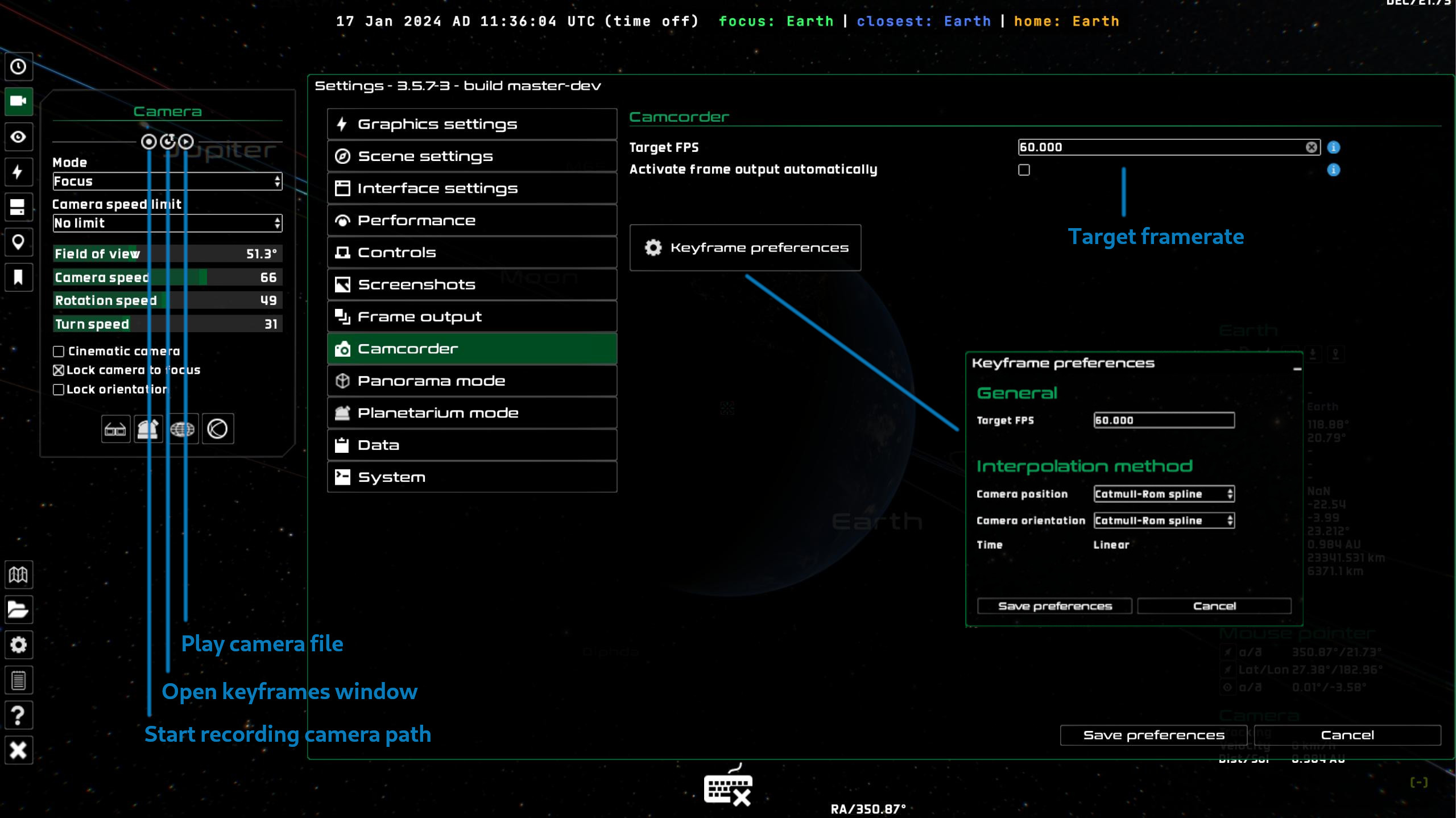
Camera Paths
- Record camera paths to
.gscfiles - Play back camera path files
Keyframes System
- Define camera paths visually
- Smoothing, time normalization, etc.
- Save keyframes file to
.gkffile - Export to
.gscfile
Keyframes System
Scripting
-
Gaia Sky API → Python via Py4j
- Also, see REST API via HTTP
- Modify settings
- Manipulate camera
- Control time
- Add, remove, modify objects and datasets
- Run code snippets after every frame
- Much more: later in session

Modes
of Operation in Gaia Sky
Operation Modes
- Desktop, single-view mode
- Virtual Reality
- Panorama ($360^\circ$)
- Planetarium
- Orhtosphere
- Stereoscopic (3D)
- Multiple projectors with MPCDI
Gaia Sky VR
- VR mode using the OpenXR API directly
- Full feature set of base desktop app
-
Minimalist approach:
- As similar as possible to base Gaia Sky
- Free navigation using VR controllers
- Point&shoot for object selection
- In-scene control panel
Gaia Sky VR
Session with Valve IndexPanorama Mode
-
Render 6 scenes with $fov=90^\circ$
- +X, -X, +Y, -Y, +Z, -Z
- Use those to create a cubemap
-
Project to screen:
- Equirectangular (spherical)
- Cylindrical
- Hammer
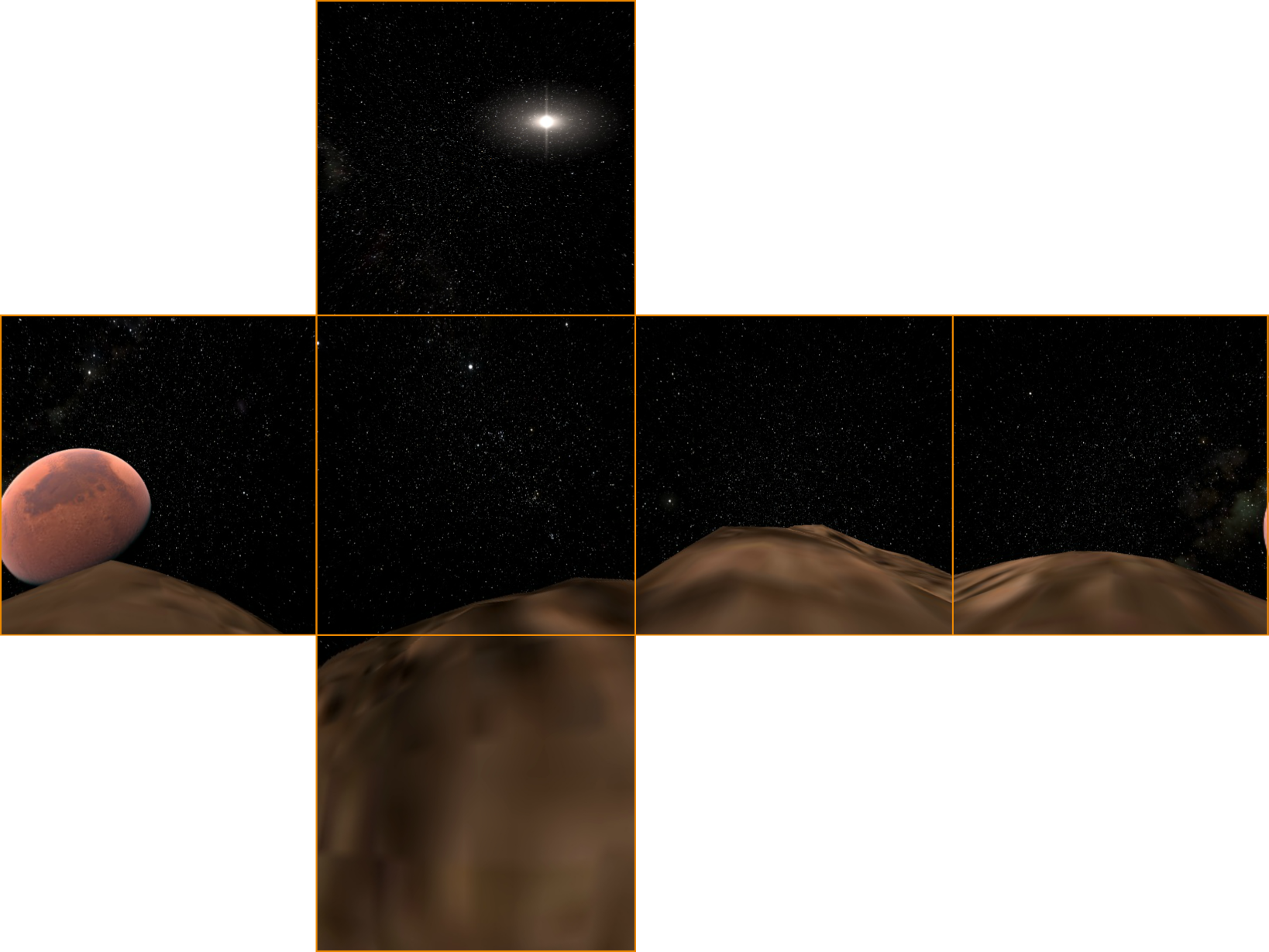
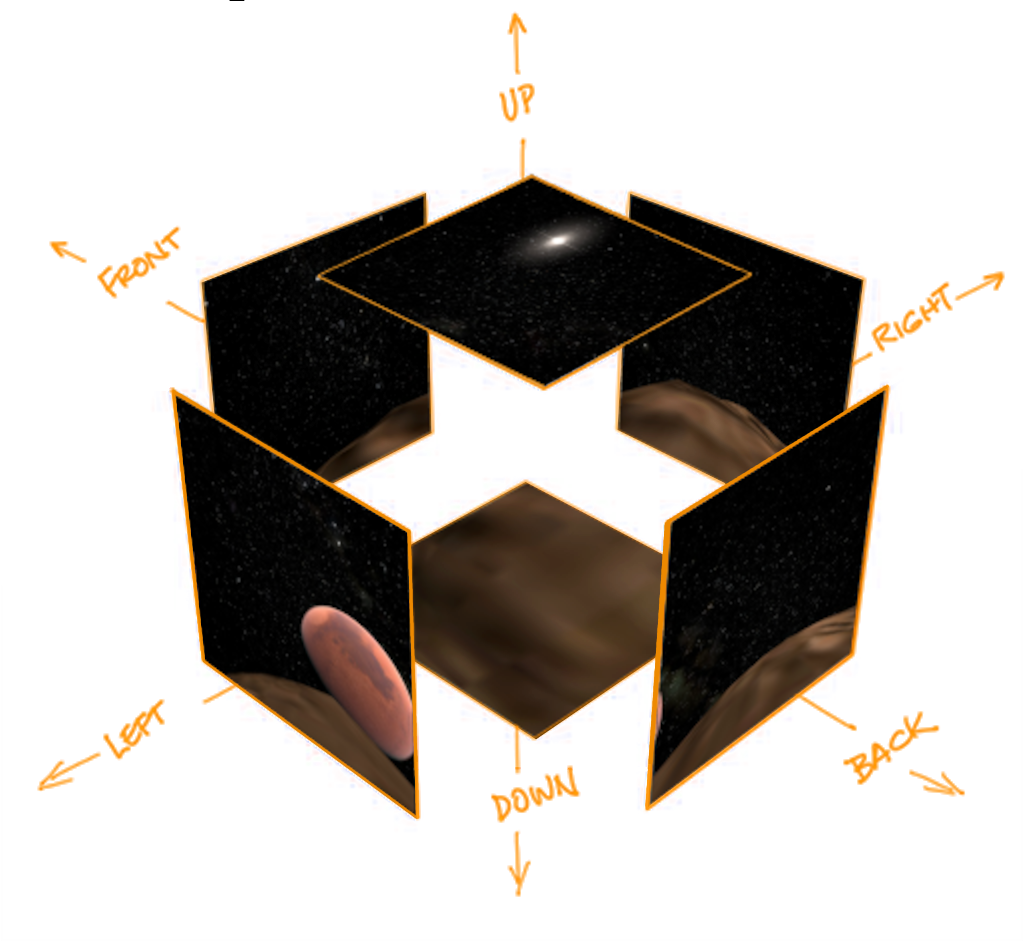
Panorama Mode
Equirectangular projectionPlanetarium Mode
- Single projector setup
- Uses cubemap from panorama mode
- Azimuthal equidistant projection (Domemaster)
- Configurable FOV → Can be greater than $180^\circ$
- Multi-projector setup
- MPCDI (Multiple Projection Common Data Interchange)
- Defines warp, frustum, etc. for each projector
Planetarium Mode
Single projectionOrthosphere Mode
- Also use cubemap
- Render two halves of sphere
- Use azimuthal equidistant
- Blend them together
- Wrap scene around in a sphere
Orthosphere
Wrap the scene around in a sphereStereoscopic Mode
-
7 profiles:
- 3DTV horizontal
- 3DTV vertical
- Anaglyph red/cyan and red/blue
- Cross-eye, parallel view
- VR simulation

Datasets
Types of datasets and catalogs in Gaia Sky
Dataset Types
- Stars → positions + other star attributes
- Variable stars → same as stars + light curves
- Particles → positions only
- Other catalogs → clusters, nebuale, iso-surfaces, etc.
- Custom objects → models, billboards, ray-marched, etc.
- SVTs → Sparse Vritual Textures
Star Datasets
$\alpha$, $\delta$, $\varpi$, $\mu_{\alpha}$, $\mu_{\delta}$, $\rho$, magnitudes, colors, names, constellations, etc.
- Regular datasets → thousands to a few million objects
- LOD (level-of-detail) → billions of objects


Regular Star Datasets
-
Gaia-based:
- DR3 tiny → 2.5M stars, 1%/0.01% bright/faint pllx. rel. err.
- DR3 weeny → 1.9M stars, 0.8%/0.01% bright/faint pllx. rel. err.
- DR3 variables → 186K Cepheid and RR Lyrae
- eDR3 white dwarfs → 359K WDs
- eDR3 GCNS → 300K stars within 100 pc
-
Other sources:
- Hipparcos (new reduction) → 120K stars
- CNS5 → 5931 nearby stars, eDR3 + Hipparcos
-
SAMP,VOTable,CSV, etc. → Load your own datasets
LOD Datasets (DR3)
| Name | Criteria | Count | Size |
| Default | 20% / 01.5% | 15 M | 1.13 GB |
| Small | 10% / 00.5% | 8.2 M | 0.61 GB |
| Medium | 30% / 05.0% | 49.9 M | 3.72 GB |
| Large | 50% / 12.5% | 122.1 M | 9.11 GB |
| Very large | 50% / 50.0% | 466.1 M | 34.79 GB |
| Extra large | 95% / 95.0% | 707.1 M | 52.78 GB |
| Bright | 90% / 01.0% | 11.2 M | 0.84 GB |
| RUWE | ruwe <= 1.4 | 111.8 M | 7.1 GB |
| Fidelity | fidelity > 0.5 | 393.6 M | 29.35 GB |
| Phot. dist | GSP-Phot distances | 470.8 M | 35.15 GB |
| Full (geodist) | N/A | 1.5 B | 109.32 GB |
Table: DR3 Gaia Sky datasets (compressed sizes)
Systems
- Star systems based on Gaia DR3
- Gaia BH2, GI876, HD114762, HD40503, J0805+4812, etc.

Galaxies
- NEARGALCAT → 875 close-by galaxies
-
SDSS → high-redshift galaxies and objects
- DR12 → 327K
- DR14 → 3M
- DR17 → 2.8M
- DR18 → 3.6M
Star Clusters
MWSC (~3K), OCDR2 (~2K), Hunt-Reffert (~7K)

Asteroids
From orbital elements → 150K DR3 asteroids

Maps
Iso-density surfaces for hot stars, HII regions, dust clouds
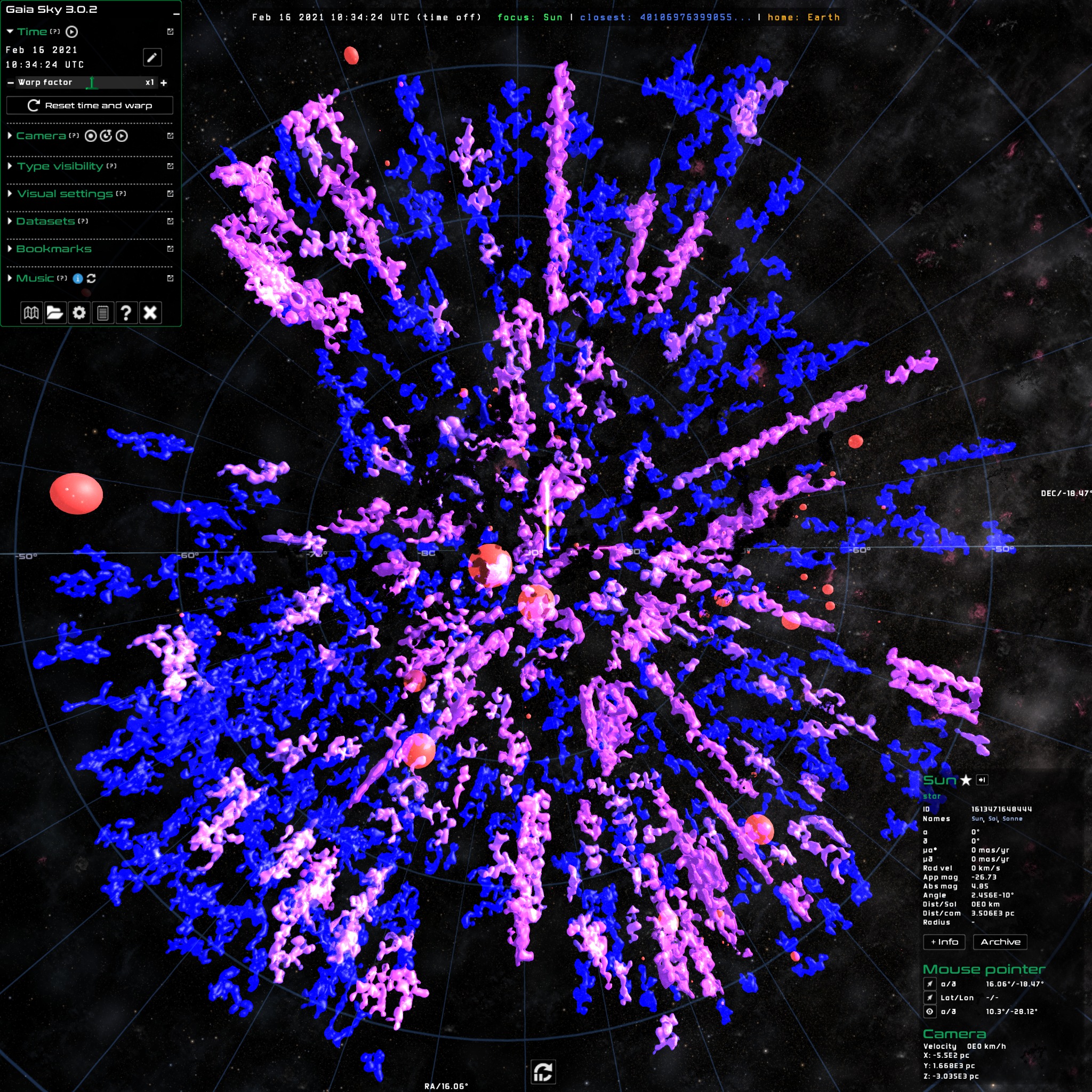
Maps
Inner view of dust (black), hot-stars (blue) and HII (red)
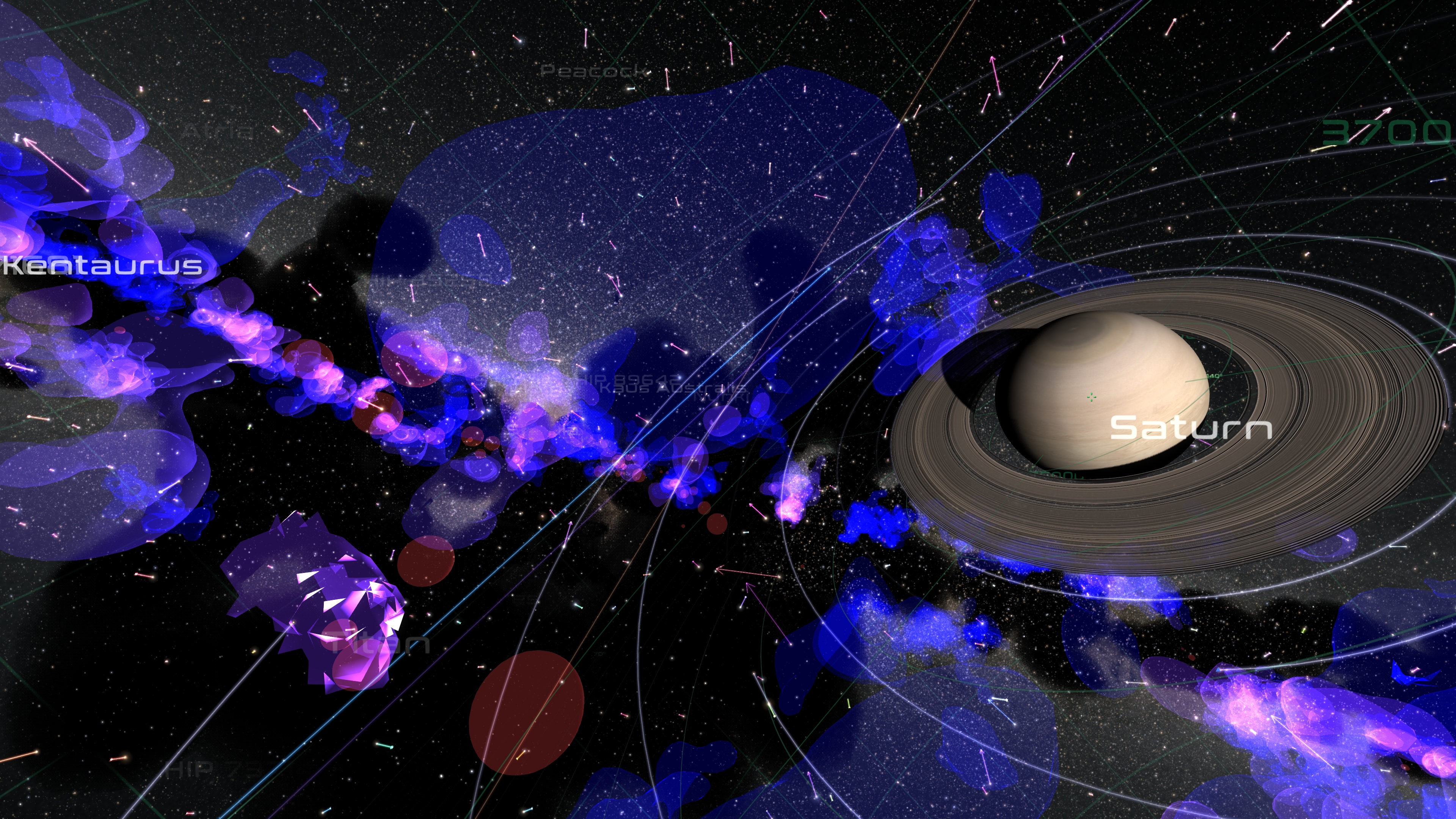
Sparse Virtual Textures (SVT)
-
Earth
- Surface (NASA VE) → 128K
- Topography (USGS) → 128K
- Clouds (Van Vliet) → 32K
-
Moon
- Surface (Van Vliet) → 64K
- Topography (LRO WAC DTM) → 8K
-
Mars
- Surface (Van Vliet) → 64K
- Topography (MOLA/USGS) → 64K

SVT in Gaia Sky
Earth topography and surface SVTsSAMP Integration
- Gaia Sky is a SAMP client
- Send datasets from Topcat, Aladin, etc.
- Tables mapped to 3D cart. or sph. coords + mags + colors
- Selection works both ways

Wrapping up
Documentation, Repository, etc.
Interested in Gaia Sky?
| Workshop scripts | |
| Video tutorials | |
| Mastodon | |
| Bluesky | |
Home Page
zah.uni-heidelberg.de/gaia/outreach/gaiasky
Documentation
gaia.ari.uni-heidelberg.de/gaiasky/docs
Source Repository
Thank You
